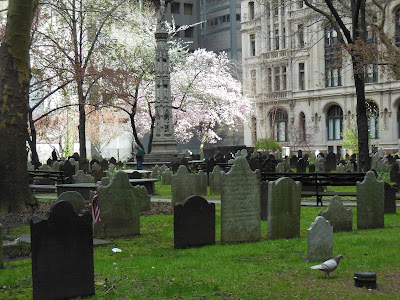Nearby is Federal Hall built on the site of the original building where George Washington took the oath of office to become the first president of the United States. On display inside is the Bible he placed his hand on for that oath. It was also the site of the first meetings of the US Congress and where the Bill of Rights was adopted.
Just a block away is Trinity Church with its beautiful and peaceful Colonial grave yard, right in the middle of the jarring clamor of the modern city.
Fraunces Tavern, also in the Lower Manhattan historic district, sits in the only remaining block of 18th century commercial buildings left in the city. It has been restored as an exact replica of the 1719 tavern where George Washington said farewell to his officers in 1783 at the close of the Revolutionary War.
The Flatiron Building, so named for its unusual triangular shape, is a favorite New York landmark which now gives its name to the whole district. When it was built in 1902 it was the tallest building in the world, and one of the first to use a steel frame. Some predicted that the winds created by the building's unusual shape would knock it down.
A pleasant summer excursion is taking a ferry out to Governor's Island which sits in the middle of New York Harbor. It is a great place to ride bikes and get a spectacular view of the lower Manhattan skyline.
Its strategic location made it valuable for the military defense of the city and later as a place to house prisoners.
The Frick Mansion on Fifth Avenue now serves as a museum housing the fabulous art collected by its owner, steel magnate Henry Clay Frick (1849-1919). It provides a rare glimpse of how the extremely wealthy lived in New York's gilded age.
The fabulous Old Westbury Gardens are on the Long Island estate of John Shaffer Pipps, an heir to a US Steel fortune. The home, built in 1906 and designed after an English country house, is surrounded by 200 acres of gardens: formal gardens, landscaped grounds, woodlands, ponds and lakes.
"Grant's Tomb" is resting place of Ulysses S. Grant and his wife Julia, located in Riverside Park on the Upper West Side. Grant emerged after four years of fighting in the Civil War as one of the great military leaders in US history. He granted humane and generous terms when General Robert E. Lee surrendered to him on April 9, 1865. His fundamental desire for peace gained him universal respect by Northerners and Southerners alike. Over the entrance to his tomb is carved, "Let us have peace."
The Hamilton Grange, in New York's Hamilton Heights Historic District, was Alexander Hamilton's summer home. It was the only home he ever owned, but he lived there for only two years, from 1802 to 1804, when he was killed in a duel with political rival Aaron Burr.
Now a National Monument, the home has several beautifully restored rooms and fascinating displays about Hamilton's life as a political writer, Revolutionary soldier, and statesman. One of the architects of our federal system of government, he was the first secretary of the treasury; his face is on our ten-dollar bill.
We thoroughly enjoyed the Intrepid Sea-Air-and-Space Museum. All the exhibits are housed on a decommissioned World War II aircraft carrier anchored in the Hudson River on the west shore of Manhattan Island.
Here we walked through the Growler, a guided-missile submarine.
The Space Shuttle Pavilion houses the historic space shuttle, Enterprise.
Dozens of planes, including fighter planes from the 1940s and the world's fastest spy plane, are displayed on the flight deck.



















No comments:
Post a Comment